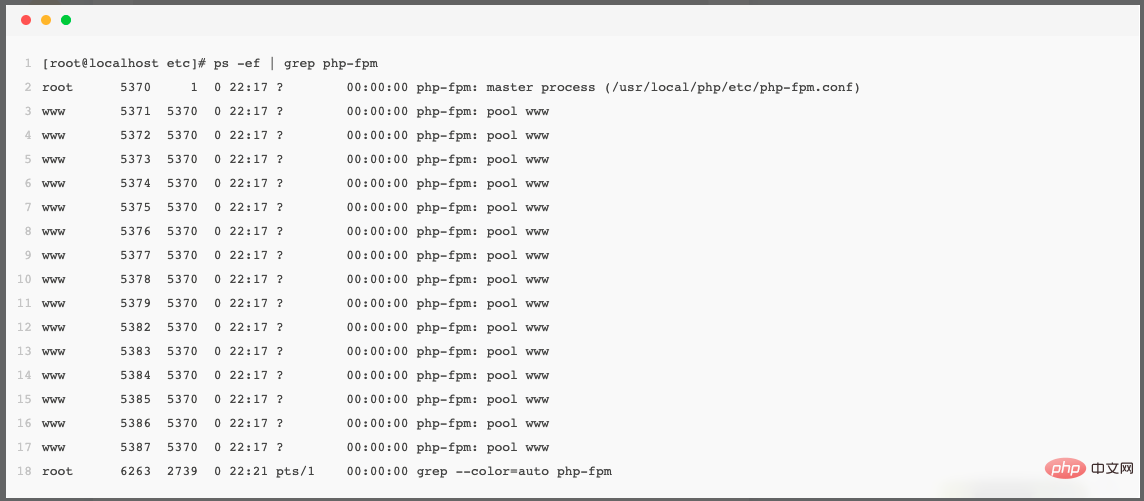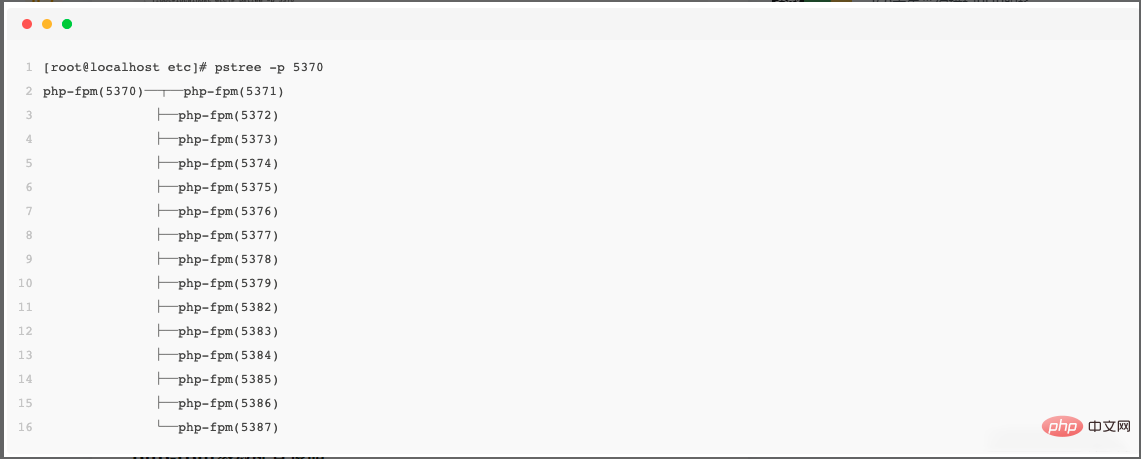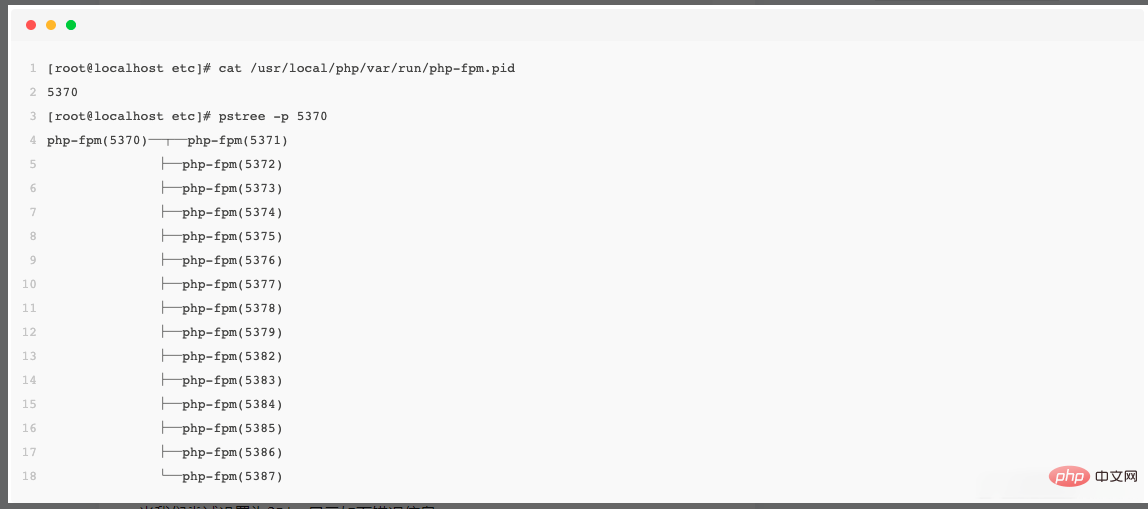PHP Process Manager PHP-FPM

What is php-fpm
php-fpm is a process manager for PHP. Many work processes under php are managed by the php-fpm process manager.
How php-fpm works
The full name of php-fpm is PHP FastCGI Process Manager. After php-fpm is started, it will first read php.ini, and then read the corresponding conf configuration file. The conf configuration can override the configuration of php.ini.
After starting php-fpm, a master process will be created to listen to port 9000 (configurable). The master process will create several sub-processes based on fpm.conf/www.conf. The sub-processes are used to handle actual business.
When a client (such as nginx) connects to port 9000, the idle child process will accept it by itself. If all child processes are busy, the new connection to be accepted will be put into the queue by the master and wait for fpm The child process is idle; the length of the queue that stores semi-connections waiting to be accepted is configured by listen.backlog.
How to view the php-fpm process and child processes
View all processes related to php-fpm. As shown in the picture below

here pool www are all sub-processes of php-fpm, which is what we often call the work process.
View the sub-processes under php-fpm
Through the above command, we can actually see the processes related to php-fpm. If we need to be more intuitive To view the master process and work process of php-fpm, you can view the process in the following way.
The 5370 here is the master process number of php-fpm. It can be clearly seen through the above command.

Through the above command, you can see that php-fpm is the master process and has 15 sub-processes below. The number of child processes here can be customized by the process. The process configuration is through the following parameters:
pm = dynamic # 动态创建子进程 pm.max_children = 20 # 最大子进程数 pm.start_servers = 15 # 初始化php-fpm进程时,默认的子进程数
php-fpm parameter configuration instructions
php-fpm global configuration parameters
#php-fpm的运行权限。 #以什么用户什么组的权限来运行池fpm。 user = www group = www #php-fpm的运行方式,可以使端口,也可以使socke文件。 #如果是端口则是走tcp,如果是socket则直接读socket文件,这样性能相对更好。 listen = 127.0.0.1:9000 #拥有socket权限的用户,需要和上面的user、group配置相结合。 #如果采用的端口的方式,则不配置。 listen.owner = www listen.group = www listen.mode = 0660 #这是php-fpm端口连接的地址。多个用","隔开。默认任意地址都可以连接。 #例如Nginx和php-fpm不在同一台服务器上,这里的值就是Nginx服务的ip地址。 #当Nginx和php-fpm配置在同一台服务器上,则直接写127.0.0.1即可。 listen.allowed_clients = 127.0.0.1 #pid进程文件存放的位置,当我们启用一个php服务, #则会自动创建一个该pid文件,其实我们可以直接把该文件理解理解php-fpm的进程号文件, #两则是等价的。默认为none。 pid = /opt/remi/php72/root/var/run/php-fpm/php-fpm.pid #错误日志位置,默认:安装路径 #INSTALL_PREFIX#/log/php-fpm.log。 #如果设置为syslog,log就会发送给syslogd服务而不会写进文件里。 error_log = /opt/remi/php72/root/var/log/php-fpm/error.log #PHP限制的文件扩展名 security.limit_extensions = .php .php3 .php4 .php5 .php7 #系统日志标示,如果跑了多个fpm进程,需要用这个来区分日志是谁的。 syslog.ident = php-fpm #日记登记,可选:alert, error, warning, notice, debug。 log_level = notice #紧急重启阈值,需要与下面emergency_restart_interval参数一起配置。 emergency_restart_threshold = 60 # 紧急重启阈值的时间范围。在此参数设置的时间内, # 出现SIGSEGV或SIGBUS的子进程数超过emergency_restart_threshold参数设置的值。 # 那么fpm就会优雅的重启,值是0表示off这个功能,可用的单位有:s秒,m分,h时,d天。 emergency_restart_interval = 60s #设置子进程接受主进程复用信号的超时时间。 process_control_timeout = 0 #当动态管理子进程时,fpm最多能fork多少个进程,0表示无限制, # 这是所有进程池能启动子进程的总和,谨慎使用。 process.max = 128 #设置子进程的优先级,在master进程以root用户启动时有效; #如果没有设置,子进程会继承master进程的优先级,值范围-19(最高)到20(最低),默认不设置。 process.priority = -19 #设置成no用于调试bug,默认为yes。 daemonize = yes #master进程最多能打开的文件数量。默认采用系统设置的值。 rlimit_files = 1024 #master进程核心rlimit限制值;可选unlimited或>=0的整数,默认为系统的值。 rlimit_core = 0 #事件处理机制,默认自动检测,可选值:select,poll, #epoll(linux>=2.5.44),kqueue,/dev/poll,port events.mechanism = epoll #fpm想系统发送状态的频率。单位有s,m,h。 #前提是fpm被设置会系统服务。 systemd_interval = 10s
php-fpm's process process pool configuration
#php-fpm的队列长度。 listen.backlog = 65535 #php进程池权限,同样要master进程是root用户才有效, #和上面的全局设置一样,不设置的话会继承master进程的优先级。 process.priority = -19 #子进程管理方式 #static(静态配置,在启动php-fpm时根据该值创建固定的子进程数量); #dynamic(动态配置,在启动php-fpm时根据pm.start_servers的值初始化对应的子进程数,至少一个子进程); #ondemand(按需配置,在启动php-fpm时不创建子进程,而是根据请求动态fork子进程); pm = dynamic #最大子进程数量 pm.max_children = 5 #初始化子进程数量,与上面的pm = dynamic配置使用。 pm.start_servers = 2 #服务器闲置时最少保持2个子进程,不够这个数就会创建,只适用动态dynamic管理方式 pm.min_spare_servers = 2 #服务器闲置时最多要有几个,多了会kill,只适用动态dynamic管理方式 pm.max_spare_servers = 3 #子进程闲置时间,也就是说子进程没有可处理的任务时,在该之间使就会被killed。 pm.process_idle_timeout = 10s #每个子进程最大的处理请求数量。在一定程度上可以防止内存泄漏。 pm.max_requests = 500 #php-fpm状态监控的uri pm.status_path string #php-fpm监控页面的 ping 网址。 #如果没有设置,则无法访问 ping 页面。 #该页面用于外部检测php-fpm是否存活并且可以响应请求。请注意必须以斜线开头(/)。 ping.path string #用于定义ping请求的返回响应。返回为 HTTP 200 的 text/plain 格式文本。默认值:pong。 ping.response string #设置worker的nice(2)优先级(如果设置了的话)。 #该值从 -19(最高优先级) 到 20(更低优先级)。 #默认值:不设置 process.priority int #检测路径时使用的前缀 prefix string #访问文件日志,没啥用处,比如yii2每次都记录访问index.php,只是记录真实的PHP文件。 access.log = var/log/$pool.access.log #php的慢日志 slowlog = var/log/$pool.log.slow #慢日志时间阈值 request_slowlog_timeout = 2s #单个请求的超时时间,当php.ini设置的最大执行时间未生效,则交由它来处理。 request_terminate_timeout = 3s #最大打开句柄数,默认为系统值。 rlimit_files = 1024 #最多的核心使用数,默认为系统分配。 rlimit_core = 0
Partial configuration demonstration
php-fpm's backlog size setting
The backlog size setting of php-fpm is related to the processing capability of php-fpm, not bigger is better.
When the value is set too large, php-fpm cannot handle it, and nginx will wait for a timeout, disconnect, and report a 504 gateway timeout error. At the same time, when php-fpm finished processing and prepared the write data for nginx, it found that the TCP connection was disconnected and reported "Broken pipe".
When this value is set too small, client requests such as nginx cannot enter the accept queue of php-fpm at all, and a "502 Bad Gateway" error is reported. Therefore, the size of the backlog must be determined based on the QPS of php-fpm. The best calculation method is QPS=backlog.
php-fpm startup mode
php-fpm starts by socket or port. These two methods are configured according to the actual situation.
nginx and php-fpm are on the same server. At this time, unix socket inter-process communication can be used directly instead of tcp port communication, which can save the time of creating a connection and thereby improve performance. The sock file can be created anywhere, as long as fpm has the permission to write the file in that directory and nginx has the permission to read it. The tcp connection will be more stable because the TCP protocol ensures the correctness of the data, but sock has fewer data copies and context switches, and consumes less resources. However, socket can only be used when nginx and fpm are on the same machine.
How to choose socket startup or port startup.
Because the tcp method has higher concurrency than the unix method, it is recommended to use the tcp method for projects with high concurrency. Now the Nginx configuration sample file defaults to the tcp method.
Using the unix method, the optimization point is to place the socket file under the /dev/shm directory. The general meaning is that the files under the directory are not stored on the hard disk, but are stored on the hard disk. in memory. As for hard disk reading and memory reading, who is faster and who is slower? Memory is definitely the fastest.
How to view the socket file when starting in socket mode.
The socket file is based on the pid configuration item mentioned above. We can directly use the cat command to view the process number.

The default number of child processes to start. Through the above pm = dynamic configuration, we know that this method dynamically configures the size of the child process. At the same time, we can also set the default number of child processes. Number of processes.
pm = dynamic pm.max_children = 20 ### 默认15个子进程,演示的效果就是上面的shell命令的结果图。 pm.start_servers = 15
When we try to set it to 3, the following error message is displayed.

Explanation, there is a certain relationship between the start_servers configuration item here and the min_spare_servers configuration. We set it to a minimum of 10, and php-fpm can be started normally.
Recommended tutorial: "PHP"
The above is the detailed content of PHP Process Manager PHP-FPM. For more information, please follow other related articles on the PHP Chinese website!

Hot AI Tools

Undresser.AI Undress
AI-powered app for creating realistic nude photos

AI Clothes Remover
Online AI tool for removing clothes from photos.

Undress AI Tool
Undress images for free

Clothoff.io
AI clothes remover

AI Hentai Generator
Generate AI Hentai for free.

Hot Article

Hot Tools

Notepad++7.3.1
Easy-to-use and free code editor

SublimeText3 Chinese version
Chinese version, very easy to use

Zend Studio 13.0.1
Powerful PHP integrated development environment

Dreamweaver CS6
Visual web development tools

SublimeText3 Mac version
God-level code editing software (SublimeText3)

Hot Topics
 1386
1386
 52
52
 Alipay PHP SDK transfer error: How to solve the problem of 'Cannot declare class SignData'?
Apr 01, 2025 am 07:21 AM
Alipay PHP SDK transfer error: How to solve the problem of 'Cannot declare class SignData'?
Apr 01, 2025 am 07:21 AM
Alipay PHP...
 Explain JSON Web Tokens (JWT) and their use case in PHP APIs.
Apr 05, 2025 am 12:04 AM
Explain JSON Web Tokens (JWT) and their use case in PHP APIs.
Apr 05, 2025 am 12:04 AM
JWT is an open standard based on JSON, used to securely transmit information between parties, mainly for identity authentication and information exchange. 1. JWT consists of three parts: Header, Payload and Signature. 2. The working principle of JWT includes three steps: generating JWT, verifying JWT and parsing Payload. 3. When using JWT for authentication in PHP, JWT can be generated and verified, and user role and permission information can be included in advanced usage. 4. Common errors include signature verification failure, token expiration, and payload oversized. Debugging skills include using debugging tools and logging. 5. Performance optimization and best practices include using appropriate signature algorithms, setting validity periods reasonably,
 Describe the SOLID principles and how they apply to PHP development.
Apr 03, 2025 am 12:04 AM
Describe the SOLID principles and how they apply to PHP development.
Apr 03, 2025 am 12:04 AM
The application of SOLID principle in PHP development includes: 1. Single responsibility principle (SRP): Each class is responsible for only one function. 2. Open and close principle (OCP): Changes are achieved through extension rather than modification. 3. Lisch's Substitution Principle (LSP): Subclasses can replace base classes without affecting program accuracy. 4. Interface isolation principle (ISP): Use fine-grained interfaces to avoid dependencies and unused methods. 5. Dependency inversion principle (DIP): High and low-level modules rely on abstraction and are implemented through dependency injection.
 How to automatically set permissions of unixsocket after system restart?
Mar 31, 2025 pm 11:54 PM
How to automatically set permissions of unixsocket after system restart?
Mar 31, 2025 pm 11:54 PM
How to automatically set the permissions of unixsocket after the system restarts. Every time the system restarts, we need to execute the following command to modify the permissions of unixsocket: sudo...
 How to debug CLI mode in PHPStorm?
Apr 01, 2025 pm 02:57 PM
How to debug CLI mode in PHPStorm?
Apr 01, 2025 pm 02:57 PM
How to debug CLI mode in PHPStorm? When developing with PHPStorm, sometimes we need to debug PHP in command line interface (CLI) mode...
 Explain the concept of late static binding in PHP.
Mar 21, 2025 pm 01:33 PM
Explain the concept of late static binding in PHP.
Mar 21, 2025 pm 01:33 PM
Article discusses late static binding (LSB) in PHP, introduced in PHP 5.3, allowing runtime resolution of static method calls for more flexible inheritance.Main issue: LSB vs. traditional polymorphism; LSB's practical applications and potential perfo
 How to send a POST request containing JSON data using PHP's cURL library?
Apr 01, 2025 pm 03:12 PM
How to send a POST request containing JSON data using PHP's cURL library?
Apr 01, 2025 pm 03:12 PM
Sending JSON data using PHP's cURL library In PHP development, it is often necessary to interact with external APIs. One of the common ways is to use cURL library to send POST�...
 Explain late static binding in PHP (static::).
Apr 03, 2025 am 12:04 AM
Explain late static binding in PHP (static::).
Apr 03, 2025 am 12:04 AM
Static binding (static::) implements late static binding (LSB) in PHP, allowing calling classes to be referenced in static contexts rather than defining classes. 1) The parsing process is performed at runtime, 2) Look up the call class in the inheritance relationship, 3) It may bring performance overhead.




